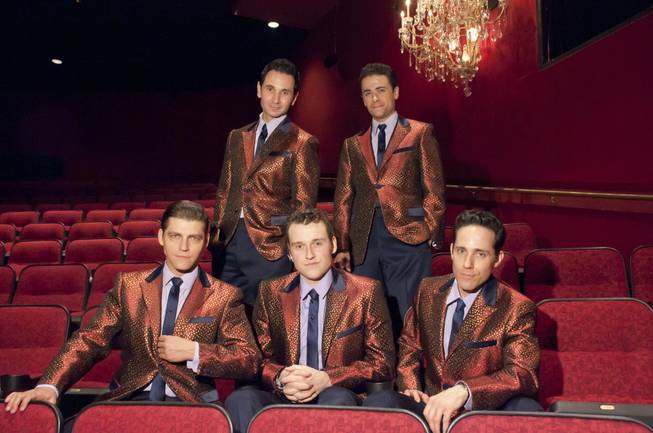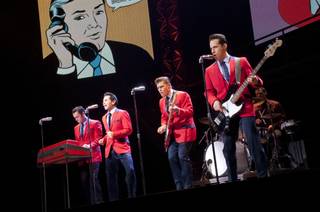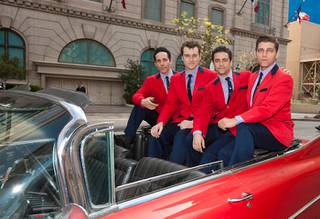
The cast of “Jersey Boys” at their new home in the Paris. From left, back row: Travis Cloer and Graham Fenton. Front row: Deven May, Rob Marnell and Jeff Leibow.
Wednesday, March 7, 2012 | 6 p.m.
“Jersey Boys” has for years enjoyed wide appeal, selling out theaters on Broadway, in London and on tour across the country. In its new Las Vegas venue, the company is finding a different sort of wide appeal -- that of a physically wider stage on which to rock ’n’ roll.
Having spent the first 3½ years of its Las Vegas run at the Palazzo, the musical adaptation of the rise of Frankie Valli and the Four Seasons has been one of the city’s top productions. That affiliation ended in December, and the show reopened at the Paris Theatre at Paris Las Vegas on Monday night.
The most obvious difference in the two venues is that the Paris Theatre is wider than the show’s former home at the Palazzo. It’s just 12 feet of added space but represents a significant piece of territory in a show where every move and moment is expertly choreographed.
The difference?
“We can stand wider,” says Deven May, who has played Tommy DeVito since the show opened in Las Vegas in May 2008. “Things have moved out because it’s such a wide seating area, and we can move out a little, too.”
In basketball, that’s called “spacing,” giving the team with possession of the ball more room to execute its half-court offense. For “Jersey Boys,” the bigger stage gives the show an unrealized breadth.
“It feels less deep than some of the other stages,” says Jeff Leibow, who plays Nick Massi. “At first, it seemed intimidating as they were lighting it, knowing what this enormous stage does.”
The performers say they feel as if they are in a concert venue.
“It makes it really a rock ’n’ roll, open venue, exactly like you’d see at a rock concert,” Leibow says. “The (lighting) truss that goes around the stage looks just like what you would see going around a rock 'n' roll concert … the old stage, it didn’t really feel like that. It was just like a theater set. But now, it feels like we’ve gone from a theater to an arena.”
The performers have adjusted how they address the audience during the show, both musically and in spoken dialogue.
“Because it’s such a wide seating area, we need to play to people who are seated on the sides,” May says. “Because of that, each scene does feel like it’s truly a separate scene. Before, we would bleed more into the center of the stage and feel like it was all in the middle, but here it’s like watching vignettes throughout the show.”
The newest member of the Vegas cast is Rob Marnell, who plays Bob Gaudio in the Paris version. As he notes, “We talk to the audience a lot, all throughout the show. In other companies, everybody is told, ‘Make sure you play to the balcony,’ but our challenge is not that.”
That’s because there is no balcony at the Paris Theatre.
“Our challenge here is to include the people on the sides in the far wings,” Marnell says.
As the show went dark to allow for the move south on the Strip to the Paris, the actors were given time to delve back into their characters. Director Des McAnuff worked with each performer on fine-tuning their portrayals of the four central characters. Music Director Ron Melrose added his insight about the music and what the construction of each piece means to the flow and tenor of the show.
“We’ve been playing scenes a certain way for so long, and now we’re taking the same exact words in those scenes and the directors are saying, ‘Now, play it this way,’ ” says Travis Cloer, who toggles the Valli role with Graham Fenton (the vocal demand has always required two actors in the Valli role for the Las Vegas production). “Now those words take on a completely new and different meaning.”
Cloer says that process is evident, to varying degrees, in 90 percent of his scenes. An example that rings out is in the second act, where Frankie and his journalist love interest, Lorraine, are talking on the catwalk high above the stage. This scene takes place after Lorraine has interviewed the band and tells Frankie that Tommy has hit on her.
“Before, I was playing that scene in a more internal way, delivering the conversation to her,” Cloer says. “It’s very intense. Our director gave me a different way to think about it. He said, ‘Play that out, play it as if you’re talking to Tommy and Lorraine’s not even in the room.’ (Frankie) is so upset, and now he’s delivering all that angst and anger toward this mental image of Tommy, and he doesn’t even see Lorraine standing there.”
Often overlooked in the staging, costumes and music -- all of which remain unchanged -- is that “Jersey Boys” is very well-written. One of the many great lines is from the Massi character, who explains his decision to leave the group with the open-ended line, “When there are four guys, and you’re Ringo …” We get that reasoning.
As May says, “The story is the star. That’s what we’re celebrating.”
Follow John Katsilometes on Twitter at Twitter.com/JohnnyKats. Also, follow “Kats With the Dish” at Twitter.com/KatsWithTheDish.




Join the Discussion:
Check this out for a full explanation of our conversion to the LiveFyre commenting system and instructions on how to sign up for an account.
Full comments policy